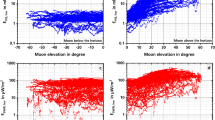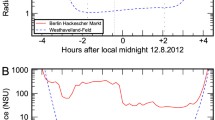Summary
In this paper is presented an analysis of the natural illumination data assembled at Pretoria (Union of South Africa) during 1955. The results are the first available for the Southern Hemisphere regarding the intensities of the total luminous flux, through a horizontal surface, and also of its component due to skylight. The basic instrumentation and the record standardization procedures have been discussed in a previous contribution. The main results are compared with those derived at Kew (England), Tashkent (U. S. S. R.), Vienna (Austria), and Washington (U. S. A.).
Estimates of the luminous efficiency of daylight, defined as the ratio day-light intensity/radiation intensity, are provided for cloudless and overcast skies at Pretoria. Representative values are tabulated for seasonal variation of the luminous efficiency at those places where such information is available.
Zusammenfassung
In der vorliegenden Untersuchung werden die Beobachtungen der Tageshelligkeit diskutiert, die während das Jahres 1955 in Pretoria (Südafrikanische Union) angestellt wurden; es sind dies die ersten, für die Südhemisphäre gültigen Resultate für den gesamten Helligkeitsstrom durch eine Horizontalfläche und für ihre Himmelslichtkomponente. Instrumentelle Grundlagen und Eichverfahren wurden in einer früheren Veröffentlichung diskutiert. Die Hauptergebnisse werden mit Messungen von Kew, Taschkent, Wien und Washington verglichen.
Schätzungen des durch den Quotienten der Tageshelligkeit zur Strahlungsintensität definierten photometrischen Strahlungsäquivalents werden für wolkenlosen und für bedeckten Himmel in Pretoria aufgestellt. Repräsentative Werte des jahreszeitlichen Ganges dieses Strahlungsäquivalents werden für diejenigen Orte mitgeteilt, für die die benötigten Unterlagen vorliegen.
Résumé
Discussion des mesures d'éclairement naturel effectuées à Pretoria (Union sud-africaine) en 1955; ce sont les premiers résultats valables pour l'hémisphère sud concernant le flux total d'éclairement à travers une surface horizontale et ses composantes célestes. Les questions instrumentales et d'étalonnage ont été examinées dans une publication antérieure. Comparaison des principaux résultats avec les mesures faites a Kew, Tachkent, Vienne et Washington.
L'auteur a procédé à des estimations de l'efficacité lumineuse déduite du quotient de l'éclairement naturel par l'intensité de rayonnement pour les jours sans nuages et les jours couverts à Pretoria; il en donne la variation saisonnière pour les localités où furent faites les mesures nécessaires.
Similar content being viewed by others
References
Blackwell, M. J.: Five Years' Continuous Recording of Daylight Illumination at Kew Observatory. Met. Res. Ctee., M. R. P. no. 831 (1953).
Blackwell, M. J.: Five Years' Continuous Recording of Total and Diffuse Solar Radiation at Kew Observatory. Met. Res. Ctee., M. R. P. no. 895 (1954).
Blackwell, M. J., andD. B. B. Powell: On the Development of an Improved Daylight Illumination Recorder. Met. Res. Ctee., M. R. P. no. 988 (1956).
Drummond, A. J.: Notes on the Measurement of Natural Illumination. I. Some Characteristics of Illumination Recorders. Arch. Met. Geoph. Biokl. B7, 437 (1956).
International Union of Geodesy and Geophysics,Radiation Commission: Radiation Instruments and Measurements. Ann. International Geophys. Year, Vol. V. London-New York: Pergamon Press, 1958.
Johnson, F. S.: The Solar Constant. J. Met.11, 431 (1954).
Jones, L. A., andH. R. Condit: Sunlight and Skylight as Determinants of Photographic Exposure. I. Luminous Density as Determined by Solar Altitude and Atmospheric Conditions. J. Opt. Soc. Amer.38, 123 (1948).
Lopukhin, E. A.: Natural Daylight in Tashkent. Bull. Acad. Sci. USSR, Ser. Geoph.5, 469 (1953).
Nicolet, M.: Sur la détermination du flux énergétique du rayonnement extraterrestre du soleil. Arch. Met. Geoph. Biokl. B3, 209 (1951).
Sauberer, F.: Übersicht über die Strahlungsverhältnisse an der Zentralanstalt für Meteorologie und Geodynamik, Wien. Sonderdruck aus der Forschungsgemeinschaft für Großstadtprobleme (Bioklimatische Gruppe). Wien: Robicodruck, 1956.
Smithsonian Institution: Smithsonian Meteorological Tables, 6th revised ed., ed.R. J. List, p. 442. Washington, 1951.
Stair, R. andR. G. Johnston: Preliminary Spectroradiometric Measurements of the Solar Constant. J. Res. Nat. Bur. Stand.57, 205 (1956).
U. S. Weather Bureau: Climatological Data, National Summaries 1953–1956, Asheville.
Author information
Authors and Affiliations
Additional information
With 4 Figures
This paper which has been developed from a protion of a contribution presented before the Optical Society of America, at Lake Placid, October 18–20, 1956, is dedicated toDr. Anders K. Ångström on the occasion of his 70th birthday.
Rights and permissions
About this article
Cite this article
Drummond, A.J. Notes on the measurement of natural illumination II. Daylight and skylight at Pretoria; The luminous efficiency of daylight. Arch. Met. Geoph. Biokl. B. 9, 149–163 (1958). https://doi.org/10.1007/BF02242906
Issue Date:
DOI: https://doi.org/10.1007/BF02242906




